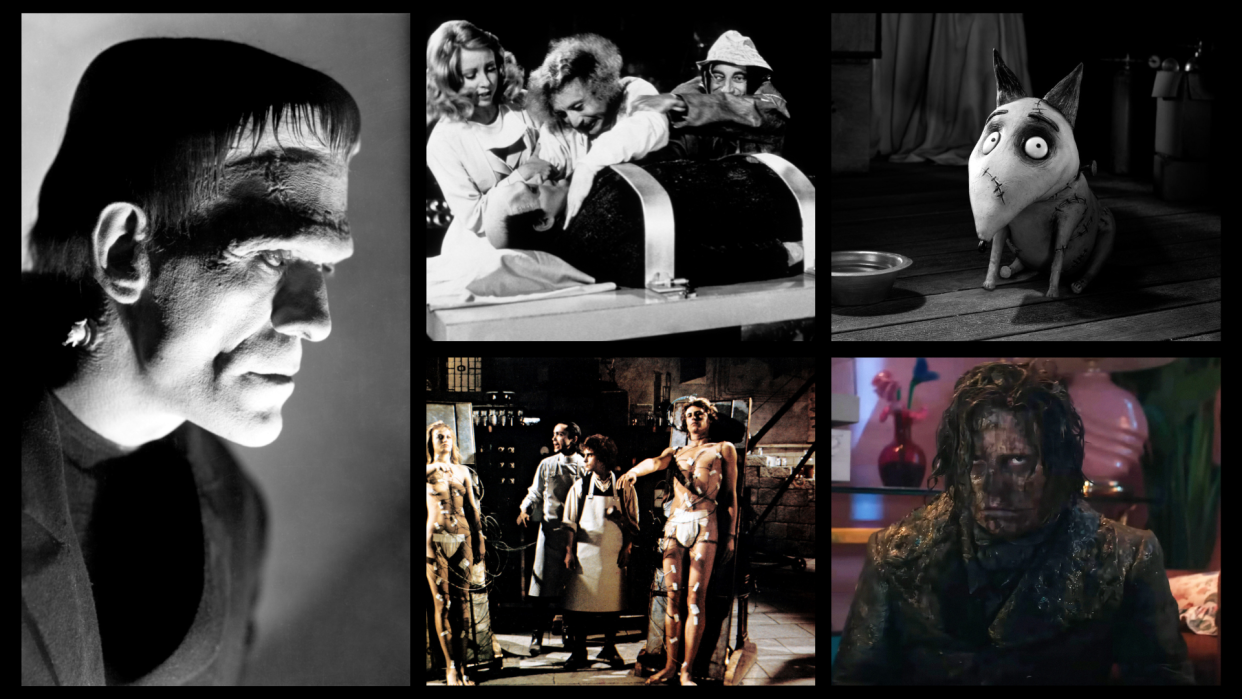The History of Frankenstein on Film: ‘Flesh for Frankenstein,’ ‘Young Frankenstein,’ ‘Lisa Frankenstein,’ and More

- Oops!Something went wrong.Please try again later.
- Oops!Something went wrong.Please try again later.
- Oops!Something went wrong.Please try again later.
- Oops!Something went wrong.Please try again later.
- Oops!Something went wrong.Please try again later.
The story behind the novel is almost as famous as the novel itself: in the summer of 1816, Mary Shelley and her husband Percy Shelley traveled to Lake Geneva on a trip with her stepsister Claire Claremont and Claire’s lover, poet Lord Byron. Because of the abnormally cold weather, the foursome were forced to stay indoors for nearly the entire trip, and to pass the time, Byron proposed a challenge to see who could write the scariest ghost story. Mary, a woman with a taste for the macabre, was inspired by a discussion of galvanism, a scientific theory that electricity could stimulate or create life, to write what she first thought would be a short story: the tale of a young, ambitious student playing God and creating an abomination in the process.
From that idea came quite possibly the most influential and iconic horror novel in history. Published two years later in 1818, “Frankenstein; or, the Modern Prometheus” is a terrifying, thought-provoking novel about the nature of humanity and the consequences of bringing life into the world. The titular character, as many a pedantic fan will have you know, isn’t the monster but his creator Victor Frankenstein. An idealistic Swiss scientist with a desire to change the world, Victor secretly carries out a strange, unethical experiment to create the ideal man, only to find the results of his tinkering to be a hideous and unholy creature. For centuries, the content of the book has been heavily debated and remains so to this very day, often revolving around the central question of whether the creator or his creation is the real monster.
More from IndieWire
Lily Gladstone Expands Her Empire with 'The Unknown Country' Sequel and Doc 'Bring Them Home'
'Road House' Skipped Theaters in Exchange for a Bigger Budget - Report
In the literary sphere, “Frankenstein” had a massive impact; it is frequently considered the first true work of the science fiction genre. And yet, its influence is perhaps even more clear in the world of film, where Frankenstein is one of the most commonly portrayed horror villains in history. While adaptations of Shelley’s work existed beforehand, the modern blueprint of what we think about when we think about Frankenstein is James Whale’s 1931 Universal Pictures feature, featuring Boris Karloff in a defining performance as the creature. Whale’s film heavily simplified Shelley’s complex work, which uses an epistolary framework and alternating points of view, making for a leaner and compressed narrative. But the movie was a hit, and along with “Dracula” that same year cemented Universal as the destination for creature features. Several sequels were made (the first, “The Bride of Frankenstein,” is frequently considered superior to the original), establishing Karloff’s lumbering green zombie as the most popular image of “Frankenstein.”
Karloff’s monster remains perhaps the defining classic horror monster; parodies of his portrayal are endless, including classic spoofs like “Young Frankenstein” or kid-friendly works like “Frankenweenie.” Almost every “Frankenstein” adaptation owes something to Whale’s original film, including more faithful adaptations of the original novel like 1994’s “Mary Shelley’s Frankenstein.” And new interpretations continue to trickle out in Hollywood; currently, Guillermo Del Toro is prepping an adaptation of the novel with Oscar Isaac as the scientist and Jacob Elordi as the monster.
But perhaps most interesting are the revisionist takes on the creature, ones that either heavily depart from Shelley’s text or take the basic scientific creation conceit and run wild with it in an entirely new narrative. Various riffs on Shelley’s original novel play up the book’s sexual undertones, with movies like “Flesh For Frankenstein” and “The Rocky Horror Picture Show” exploring the sensual and queer subtext many critics have found in Victor’s attempt to create a perfect man. Just last year, “Poor Things,” Yorgos Lanthimos’ adaptation of a novel by Alasdair Gray, took the basic premise of a man creating life and gave it a bold genderbent spin, casting Emma Stone as a female Frankenstein’s Monster slowly coming into her carnal desires via a whirlwind trip across the globe.
This February brings us a new revisionist take on the Frankenstein genre, Zelda Williams and Diablo Cody’s “Lisa Frankenstein.” Fashioned as a feminist, throwback take, the film transplants the basics of Shelley’s story to the world of ’80s teen films, featuring Kathryn Newton as an outcast who attempts to create her dream boyfriend out of a Victorian era corpse. With “Lisa Frankenstein” out in theaters, IndieWire decided to look back at notable adaptations of “Frankenstein,” from the Universal Horror series to modern riffs on the format, to explore how Shelley’s novel has birthed an entire subgenre of horror and science fiction cinema. Read on for a brief(ish) history of Frankenstein on film.
Best of IndieWire
Where to Watch This Week's New Movies, Including 'Argylle' and 'How to Have Sex'
Christopher Nolan's Favorite Movies: 40 Films the Director Wants You to See
Sign up for Indiewire's Newsletter. For the latest news, follow us on Facebook, Twitter, and Instagram.

